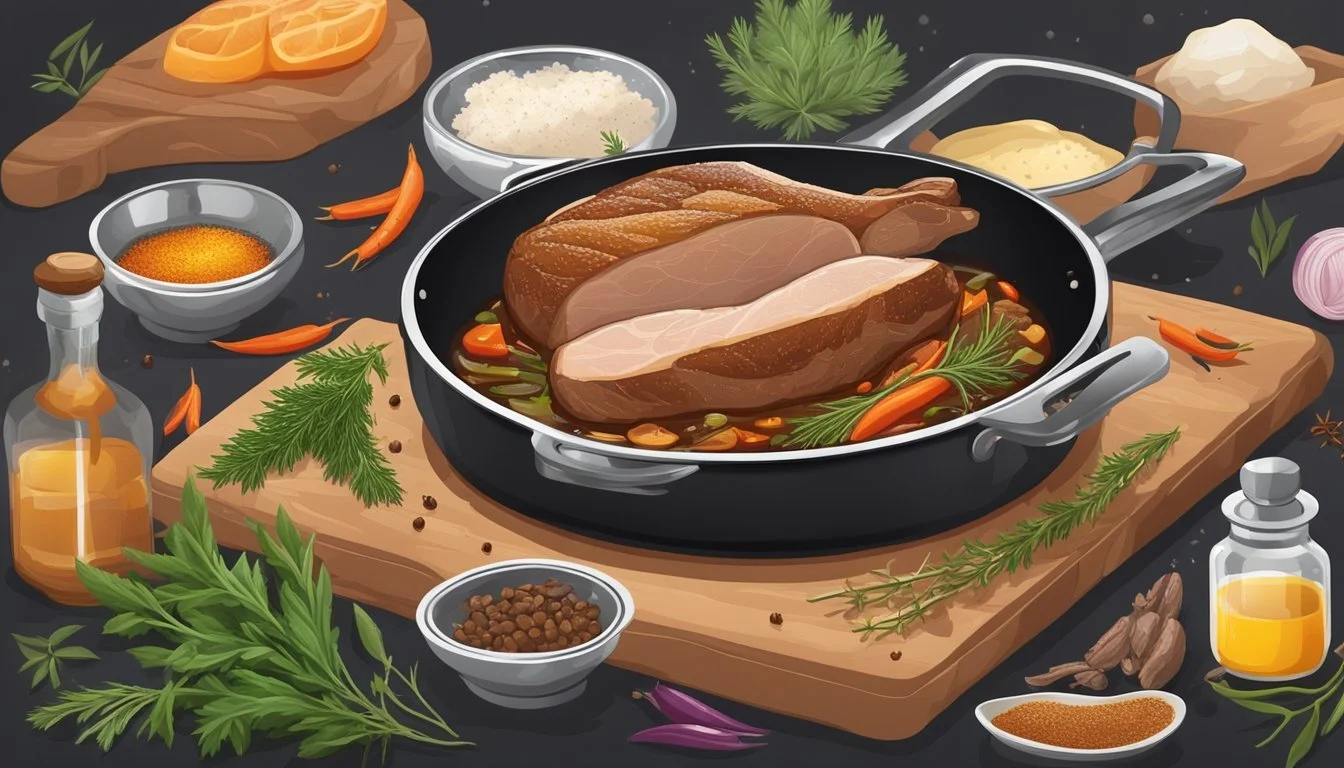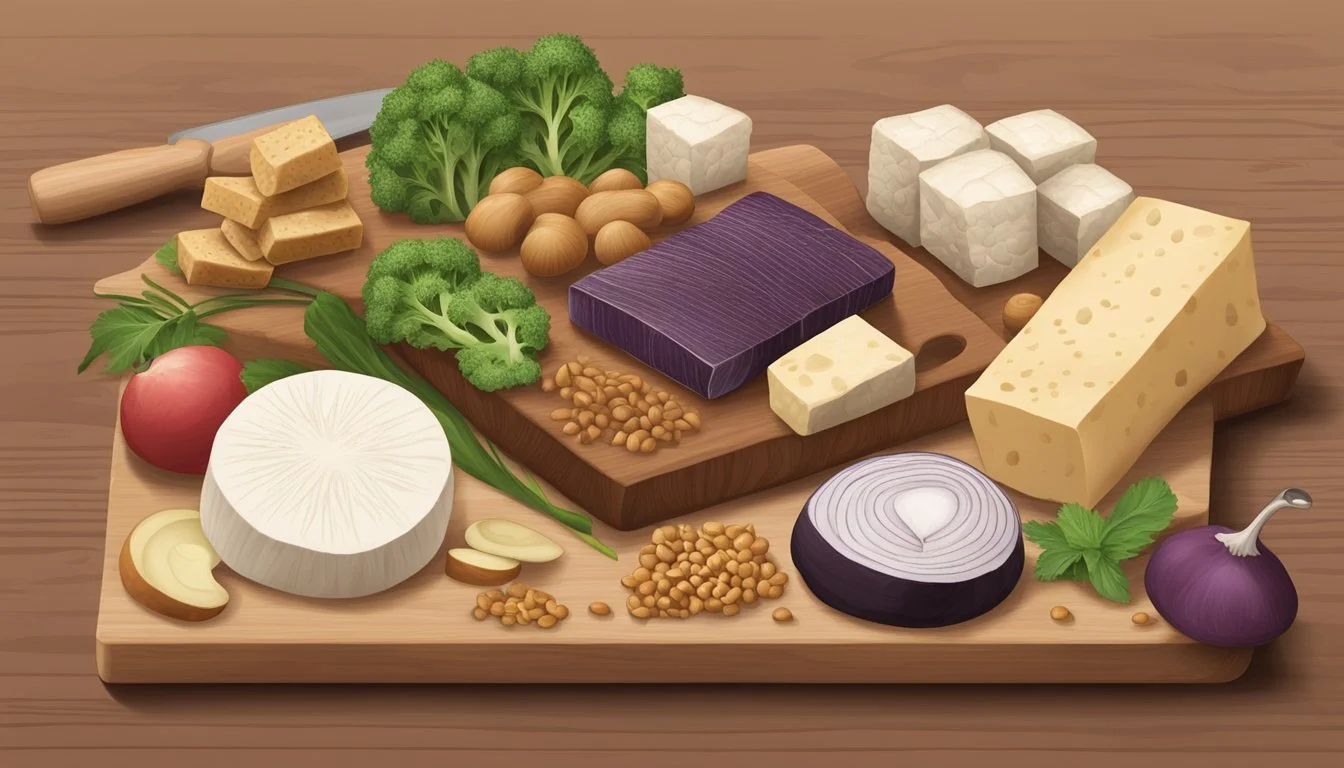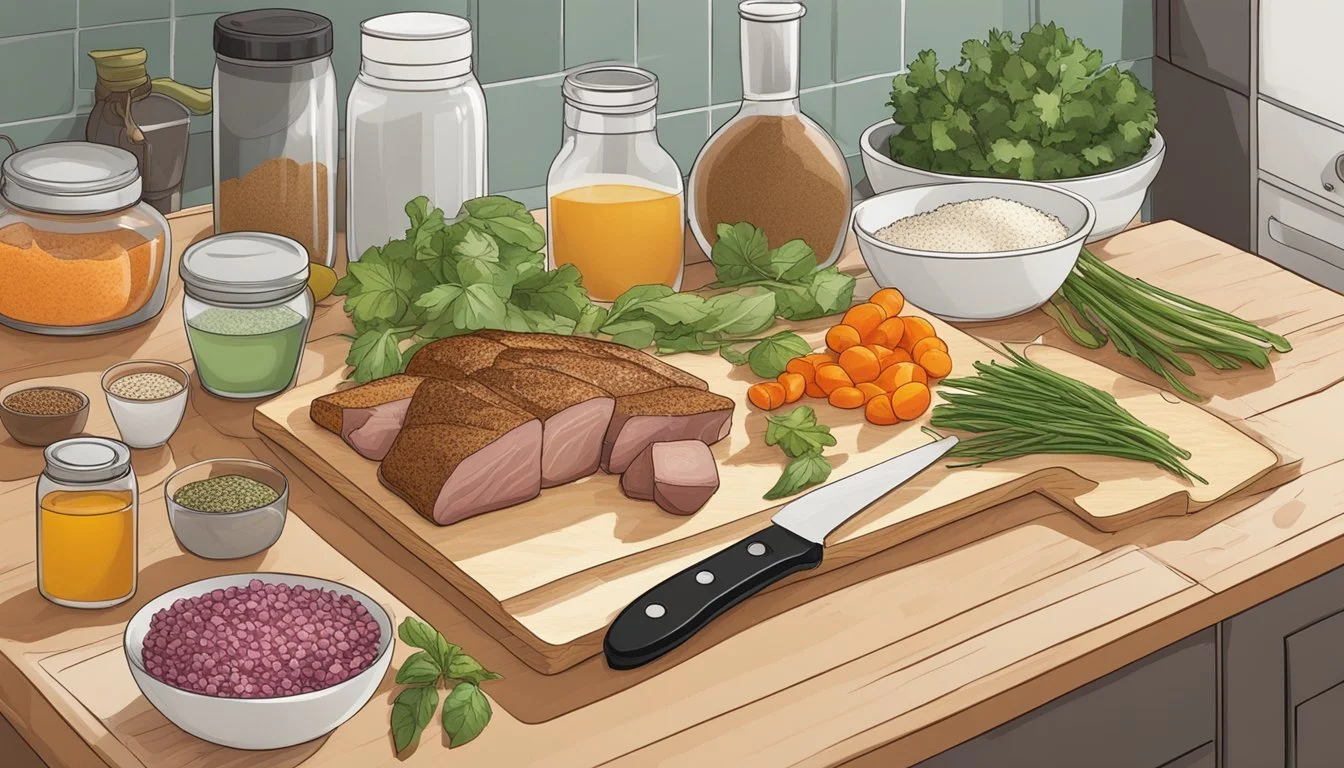Duck Breast Substitutes
Best Alternatives for Your Recipes
Duck breast is a favorite among gourmet enthusiasts, known for its rich, gamey flavor and tender texture. For those seeking a substitute, lentils offer a protein-rich alternative with a similar nutritional profile. Cooked lentils provide around 18 grams of protein per cup, making them a viable option for those looking to replicate the protein content of duck breast dishes.
Vegetarians and vegans may find lentils especially appealing due to their versatility and health benefits. High in fiber, potassium, magnesium, and folate, lentils not only mimic some of the nutritional aspects of duck breast but also contribute to a well-rounded diet. Their ability to absorb flavors makes them suitable for a variety of culinary applications, from soups and salads to hearty main dishes.
Cooking enthusiasts can get creative with their recipes by incorporating lentils into traditional duck breast pairings such as balsamic-roasted vegetables or exotic salads. This approach ensures that the dishes remain flavorful and satisfying while offering a nutritious alternative to meat.
Understanding Duck Breast
Duck breast offers a distinct flavor and texture and is rich in various nutrients essential for overall health. This section covers its unique taste, texture, and nutritional profile in detail.
Flavor Profile and Texture
Duck breast is known for its rich, gamey flavor that is stronger than that of chicken or turkey. The taste can be described as a mix of savory and slightly sweet, with a hint of earthiness. This distinct flavor is partially due to the higher fat content found in duck meat compared to other poultry.
The texture of duck breast is firm yet tender, especially when cooked properly. Unlike chicken breast, duck breast maintains its juiciness and succulent mouthfeel, provided it is not overcooked. The skin, when rendered correctly, becomes crispy and adds a delightful crunch that complements the tender meat.
Nutritional Considerations
Duck breast is a powerhouse of nutrients, offering substantial protein content, which supports muscle repair and growth. With about 18 grams of protein per 100 grams, it stands out as a great protein source.
In addition to protein, duck breast is rich in iron and zinc, essential minerals for immune function and oxygen transport in the blood. The fat content, including saturated fats, is higher in duck breast, which can impact heart health if consumed in large amounts. However, the fats also contribute to its unique flavor and texture.
While duck breast is nutritious, moderation is important due to its saturated fat content. Balancing it with other lean protein sources can help maintain a heart-healthy diet.
Popular Duck Breast Substitutes
There are several delicious alternatives to duck breast, catering to those who prefer poultry, red meat, or vegetarian and vegan options. These substitutes provide similar flavors and textures, making them suitable for various culinary needs.
Poultry Substitutes
Chicken is among the most common substitutes for duck breast. It offers a versatile flavor profile and can absorb different marinades and spices. Chicken thighs, in particular, have a comparable fat content, making them suitable for recipes requiring tender, juicy meat.
Turkey is another excellent option. It has a slightly richer taste than chicken and works well in dishes such as duck confit. Turkey breasts or thighs can mimic the dense, flavorful profile of duck meat, perfect for roasting or grilling.
Utilizing game birds like quail or Cornish hens can also provide a unique twist. These birds have a richer flavor than standard poultry and can elevate the dish’s profile, suitable for gourmet meals requiring an exotic touch.
Red Meat Alternatives
For those who enjoy the richness of duck, beef can be a good substitute. Cuts like sirloin or ribeye offer a similarly robust taste and texture. Beef can be prepared in various ways to replicate the succulence of duck breast, such as grilling or broiling.
Lamb is another substitute with a strong flavor. The leg of lamb or lamb chops can be used, leveraging their tender and rich qualities. This alternative works well in recipes that call for slow cooking or roasting.
Pork is also a viable substitute. Pork loin or pork belly, in particular, can provide the richness and fat content similar to duck. These cuts absorb marinades well and offer versatility in preparation, from pan-searing to slow roasting.
Vegetarian and Vegan Options
For vegetarian and vegan substitutions, tofu is a common choice. Its ability to absorb flavors and its firm texture make it suitable for various recipes traditionally using duck breast. Tofu can be marinated and grilled to mimic the same savory experience.
Seitan provides a chewy texture akin to meat. This wheat-based protein is excellent for those seeking a plant-based substitute with a similar mouthfeel to duck. Seitan can be flavored and cooked in many ways, making it a versatile option.
For a unique plant-based alternative, jackfruit can be utilized. When cooked, its texture resembles shredded meat, making it perfect for dishes like pulled duck. This fruit is a fantastic substitute for those with dietary restrictions or seeking a healthier, vegan option.
Cooking Methods and Techniques
Each cooking method provides a unique texture and flavor profile. Detailed techniques for roasting, baking, sautéing, frying, confit, and slow-cooking can help achieve the best results with duck breast substitutes.
Roasting and Baking
Roasting and baking are ideal for achieving a crispy exterior and tender interior. Preheat the oven to 425°F (220°C). For proteins like chicken breast, season and sear in a hot skillet before transferring to the oven for approximately 12-15 minutes. Vegetarians might use hearty vegetables such as cauliflower steaks, which can also be roasted until golden brown. These methods often require a balance of high heat to ensure even cooking without drying out the substitute.
Sautéing and Frying
Sautéing and frying offer quick cooking times and are perfect for thinner cuts or smaller pieces. Heat a small amount of oil in a skillet over medium-high heat. For tofu, cut into slices and fry for about 3-5 minutes on each side until crispy. Lentils, once cooked, can be sautéed with vegetables and spices to enhance their flavor. Temperature control is vital to prevent burning, and frequent flipping ensures even browning.
Confit and Slow-Cooking
Confit and slow-cooking are excellent for infusing deep flavors and achieving a tender texture. For confit, submerge ingredients in fat and cook at a low temperature for several hours. Mushrooms or tempeh can be slow-cooked in a seasoned broth to absorb rich, savory flavors. These methods require patience but result in a luxurious, melt-in-the-mouth experience. They are well-suited for making hearty, comforting dishes that highlight the substitute's characteristics.
Incorporating Substitutes in Recipes
When replacing duck breast in recipes, it's crucial to achieve the right balance of flavor, texture, and cooking time to ensure the dish remains satisfying and delectable.
Adjustments for Flavor and Consistency
Different substitutes can bring unique flavors and consistencies to a dish. Chicken breast is a common substitute due to its mild flavor and readily available nature. To enhance the flavor, marinating the chicken in sauces or spices can help mimic the rich taste of duck.
Turkey can also be used for its similar structure but tends to have a lighter flavor. Using duck fat or duck stock can add more authenticity to the dish without altering cooking methods.
Lentils provide a vegetarian option, offering a different texture but still delivering high protein and heartiness. They do well in soups, stews, or salads where the duck's robust flavor can be replaced with rich, savory seasonings.
Considerations for Texture and Cooking Time
Chicken breast offers a leaner texture compared to duck breast. It can dry out quickly if overcooked, so it's advised to keep an eye on cooking time. Grilling, baking, or pan-searing are effective methods to maintain juiciness.
Turkey breast is slightly denser and requires a slightly longer cooking time. Brining or using a moist cooking method can help preserve its tenderness.
Lentils absorb flavors well and offer a good bite but require a different cooking time and method. Pre-cooking before adding them to the main dish ensures they are tender and flavorful.
Pork tenderloin can also serve as a substitute, providing a comparable texture but with slightly different flavor notes. It cooks relatively quickly and pairs well with fruit-based sauces often used with duck.
By carefully considering these adjustments, it is possible to create a dish that remains flavorful and enjoyable, even without the use of duck breast.
Complementary Ingredients and Pairings
When exploring substitutes for duck breast, it's essential to consider the ingredients and pairings that can enhance and balance the flavors. Key components include vegetables and starches, sauces and dressings, and herbs and spices, which can create a well-rounded dish that delights the palate.
Vegetables and Starches
Vegetables and starches play a crucial role in complementing the rich and savory taste of duck breast substitutes. Roasted vegetables such as carrots, beets, and Brussels sprouts add depth and sweetness. Potatoes, especially when prepared with duck fat, offer both texture and flavor.
Creamy polenta or wild rice are excellent starch options, providing different textures and tastes that pair well with the substitutes. Sweet potatoes, either mashed or roasted, bring a subtle sweetness that balances savory components. Incorporating sautéed greens like kale or spinach adds a fresh and slightly bitter contrast.
Sauces and Dressings
Rich and tangy sauces can elevate the flavors of duck breast substitutes, making them more appealing. Cherry sauce, with its sweetness, complements the savory taste, creating a beautiful contrast. Balsamic reductions or balsamic-roasted vegetables provide a depth of flavor that harmonizes with the meat substitutes.
Creamy dressings such as horseradish cream or Dijon mustard sauce can add a luxurious touch. Citrus-based dressings, like a tangy orange glaze, bring a refreshing balance. For a more elaborate pairing, consider a red wine reduction, which adds sophistication and enhances the overall richness.
Herbs and Spices
Herbs and spices are fundamental in accentuating the flavors of duck breast substitutes. Traditional choices like thyme, rosemary, and sage are ideal for seasoning, imparting a classic and aromatic essence. Bay leaves and black pepper add depth without overpowering other ingredients.
For a bit of a twist, Chinese five-spice offers a unique blend that complements the meat’s richness. Garlic and shallots provide a foundational flavor that is both savory and slightly sweet. Fresh parsley or chives can garnish the dish, adding a hint of freshness and color.
Healthful Cooking with Duck Breast Substitutes
Incorporating duck breast substitutes can help you achieve a healthy and balanced diet while still enjoying delicious flavors. This section explores low-fat, high-protein options and the benefits of heart-healthy fats and cooking oils.
Low-Fat and High-Protein Options
Lentils serve as an excellent substitute for duck breast, offering about 18 grams of protein per cup of cooked lentils. This matches the protein content found in duck breast without the high fat levels. Lentils are also rich in fiber, potassium, magnesium, and folate, which contribute to a nutrient-dense meal.
Another viable option is jackfruit, which mimics the meaty texture of duck. Jackfruit provides a substantial source of dietary fiber and important nutrients while keeping fat content low. It can easily absorb marinades, making it flavorful and versatile. Using these plant-based alternatives can help reduce fat intake and boost overall protein consumption.
Heart-Healthy Fats and Cooking Oils
When preparing duck breast substitutes, choosing heart-healthy cooking oils is crucial. Olive oil is an excellent option due to its high levels of monounsaturated fats and antioxidants, which benefit heart health. It can be used in marinades or for sautéing vegetables.
Canola oil is another heart-healthy choice that is low in saturated fats and rich in omega-3 fatty acids. This oil is particularly useful for frying or baking because of its high smoke point.
For those who prefer a neutral flavor, sunflower oil is also a good candidate. High in vitamin E and low in saturated fat, it helps maintain cardiovascular health. Each of these oils contributes beneficially to heart health and supports a balanced diet while preparing duck breast substitutes.
Culinary Applications Beyond Main Dishes
Duck breast, known for its rich flavor and versatility, extends beyond being a main dish. It offers unique culinary applications in soups, stews, and appetizers, enhancing various recipes.
Soups, Stews, and Sides
Duck breast can be a savory addition to soups and stews, bringing depth and richness. Duck soup often includes aromatic vegetables, herbs, and tender pieces of duck meat. The duck’s fat renders into the broth, adding a luxurious mouthfeel.
In stews, duck breast melds well with root vegetables like carrots and parsnips. Slow-cooking ensures the meat becomes tender, while the flavors intensify, leading to a hearty dish perfect for colder months.
Duck breast can also transform traditional side dishes. Imagine potato gratin enhanced with duck fat or risotto infused with duck broth. These applications not only utilize the full profile of duck breast but also bring a novel twist to common accompaniments.
Appetizers and Delicacies
Duck breast makes exquisite appetizers. Duck pâté, for instance, is a culinary delicacy that showcases the meat's rich flavor. Blending duck liver with spices and fat, it creates a smooth spread often served on toasted baguette slices.
Duck breast carpaccio is another elegant option. Thinly sliced, it’s typically served raw or lightly cured, highlighting the meat's delicate texture and subtle taste.
For a more robust appetizer, duck spring rolls combine shredded duck meat with vegetables, wrapped in rice paper and served with dipping sauce. The versatility of duck breast allows it to enhance a range of starter courses, making it an ideal choice for diverse culinary creations.
Shopping and Storing Substitutes
When shopping for duck breast substitutes, focus on product quality and availability. Proper storage methods help maximize the shelf life and preserve the nutritional value of these alternatives.
Selecting Quality Substitutes
Poultry: Chicken and turkey are common substitutes. Look for organic or free-range options, which tend to have better texture and flavor. Check for firmness in the meat, and ensure there is no off smell.
Legumes: Lentils are a protein-rich alternative. When purchasing lentils, look for uniform color and avoid packages with debris or broken pieces. They should be stored in a cool, dry place.
Sauce Substitutes: For sauces like plum or hoisin, select brands with natural ingredients and minimal additives. Inspect packaging for a recent production date to ensure freshness.
Preservation and Shelf Life
Poultry: Refrigerate chicken and turkey within two hours of purchase. They should be stored in airtight containers or wrapped tightly in foil/plastic wrap. Use within 1-2 days or freeze for up to 9 months.
Legumes: Store lentils in an airtight container in a cool, dark pantry. Properly stored, dry lentils can last up to a year. Cooked lentils should be refrigerated and consumed within 5-7 days.
Sauces: Keep sauce substitutes like plum or sweet and sour sauce in sealed containers. Once opened, refrigerate and use within a few weeks to maintain optimal flavor and safety. Unopened sauces can be stored in the pantry for several months, as indicated by the best-before date.









